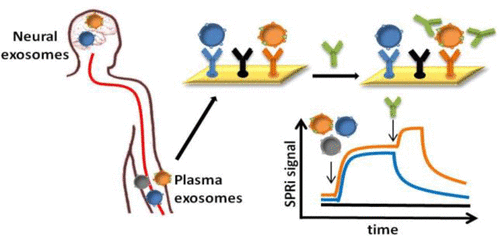当前位置:
X-MOL 学术
›
Anal. Chem.
›
论文详情
Our official English website, www.x-mol.net, welcomes your
feedback! (Note: you will need to create a separate account there.)
Detection and Characterization of Different Brain-Derived Subpopulations of Plasma Exosomes by Surface Plasmon Resonance Imaging
Analytical Chemistry ( IF 6.7 ) Pub Date : 2018-07-04 00:00:00 , DOI: 10.1021/acs.analchem.8b00941 Silvia Picciolini 1, 2 , Alice Gualerzi 1 , Renzo Vanna 1 , Andrea Sguassero 1 , Furio Gramatica 1 , Marzia Bedoni 1 , Massimo Masserini 2 , Carlo Morasso 1
Analytical Chemistry ( IF 6.7 ) Pub Date : 2018-07-04 00:00:00 , DOI: 10.1021/acs.analchem.8b00941 Silvia Picciolini 1, 2 , Alice Gualerzi 1 , Renzo Vanna 1 , Andrea Sguassero 1 , Furio Gramatica 1 , Marzia Bedoni 1 , Massimo Masserini 2 , Carlo Morasso 1
Affiliation

|
The use of exosomes for diagnostic and disease monitoring purposes is becoming particularly appealing in biomedical research because of the possibility to study directly in biological fluids some of the features related to the organs from which exosomes originate. A paradigmatic example are brain-derived exosomes that can be found in plasma and used as a direct read-out of the status of the central nervous system (CNS). Inspired by recent remarkable development of plasmonic biosensors, we have designed a surface plasmon resonance imaging (SPRi) assay that, taking advantage of the fact that exosome size perfectly fits within the surface plasmon wave depth, allows the detection of multiple exosome subpopulations of neural origin directly in blood. By use of an array of antibodies, exosomes derived from neurons and oligodendrocytes were isolated and detected with good sensitivity. Subsequently, by injecting a second antibody on the immobilized vesicles, we were able to quantify the amount of CD81 and GM1, membrane components of exosomes, on each subpopulation. In this way, we have been able to demonstrate that they are not homogeneously expressed but exhibit a variable abundance according to the exosome cellular origin. These results confirm the extreme variability of exosome composition and demonstrate how SPRi can provide an effective tool for their characterization. Besides, our work paves the road toward more precise clinical studies on the use of exosomes as potential biomarkers of neurodegenerative diseases.
中文翻译:

通过表面等离子体共振成像检测和表征血浆外泌体的不同脑源性亚群
将外泌体用于诊断和疾病监测的目的在生物医学研究中变得特别有吸引力,因为可以直接在生物体液中研究与外泌体起源的器官有关的某些特征。一个典型的例子是脑源性外泌体,可以在血浆中发现它们,并直接读出中枢神经系统(CNS)的状态。受等离激元生物传感器近来的显着发展的启发,我们设计了一种表面等离振子共振成像(SPRi)测定法,该方法利用了外泌体大小完全适合表面等离激元波深度的事实,允许检测神经源的多个外泌体亚群直接在血液中。通过使用一系列抗体,分离并检测了来源于神经元和少突胶质细胞的外泌体,并具有良好的灵敏度。随后,通过在固定的囊泡上注射第二抗体,我们能够量化每个亚群上CD81和GM1(外泌体的膜成分)的量。通过这种方式,我们已经能够证明它们不是均匀表达的,但是根据外泌体细胞的起源表现出可变的丰度。这些结果证实了外泌体组成的极端变异性,并证明了SPRi如何为它们的表征提供有效的工具。此外,我们的工作为利用外泌体作为神经退行性疾病的潜在生物标记物开展更精确的临床研究铺平了道路。我们能够量化每个亚群上外泌体膜成分CD81和GM1的数量。通过这种方式,我们已经能够证明它们不是均匀表达的,但是根据外泌体细胞的起源表现出可变的丰度。这些结果证实了外泌体组成的极端变异性,并证明了SPRi如何为它们的表征提供有效的工具。此外,我们的工作为利用外泌体作为神经退行性疾病的潜在生物标记物开展更精确的临床研究铺平了道路。我们能够量化每个亚群上外泌体膜成分CD81和GM1的数量。通过这种方式,我们已经能够证明它们不是均匀表达的,但是根据外泌体细胞的起源表现出可变的丰度。这些结果证实了外泌体组成的极端变异性,并证明了SPRi如何为它们的表征提供有效的工具。此外,我们的工作为利用外泌体作为神经退行性疾病的潜在生物标记物开展更精确的临床研究铺平了道路。这些结果证实了外泌体组成的极端变异性,并证明了SPRi如何为它们的表征提供有效的工具。此外,我们的工作为利用外泌体作为神经退行性疾病的潜在生物标记物开展更精确的临床研究铺平了道路。这些结果证实了外泌体组成的极端变异性,并证明了SPRi如何为它们的表征提供有效的工具。此外,我们的工作为利用外泌体作为神经退行性疾病的潜在生物标记物开展更精确的临床研究铺平了道路。
更新日期:2018-07-04
中文翻译:

通过表面等离子体共振成像检测和表征血浆外泌体的不同脑源性亚群
将外泌体用于诊断和疾病监测的目的在生物医学研究中变得特别有吸引力,因为可以直接在生物体液中研究与外泌体起源的器官有关的某些特征。一个典型的例子是脑源性外泌体,可以在血浆中发现它们,并直接读出中枢神经系统(CNS)的状态。受等离激元生物传感器近来的显着发展的启发,我们设计了一种表面等离振子共振成像(SPRi)测定法,该方法利用了外泌体大小完全适合表面等离激元波深度的事实,允许检测神经源的多个外泌体亚群直接在血液中。通过使用一系列抗体,分离并检测了来源于神经元和少突胶质细胞的外泌体,并具有良好的灵敏度。随后,通过在固定的囊泡上注射第二抗体,我们能够量化每个亚群上CD81和GM1(外泌体的膜成分)的量。通过这种方式,我们已经能够证明它们不是均匀表达的,但是根据外泌体细胞的起源表现出可变的丰度。这些结果证实了外泌体组成的极端变异性,并证明了SPRi如何为它们的表征提供有效的工具。此外,我们的工作为利用外泌体作为神经退行性疾病的潜在生物标记物开展更精确的临床研究铺平了道路。我们能够量化每个亚群上外泌体膜成分CD81和GM1的数量。通过这种方式,我们已经能够证明它们不是均匀表达的,但是根据外泌体细胞的起源表现出可变的丰度。这些结果证实了外泌体组成的极端变异性,并证明了SPRi如何为它们的表征提供有效的工具。此外,我们的工作为利用外泌体作为神经退行性疾病的潜在生物标记物开展更精确的临床研究铺平了道路。我们能够量化每个亚群上外泌体膜成分CD81和GM1的数量。通过这种方式,我们已经能够证明它们不是均匀表达的,但是根据外泌体细胞的起源表现出可变的丰度。这些结果证实了外泌体组成的极端变异性,并证明了SPRi如何为它们的表征提供有效的工具。此外,我们的工作为利用外泌体作为神经退行性疾病的潜在生物标记物开展更精确的临床研究铺平了道路。这些结果证实了外泌体组成的极端变异性,并证明了SPRi如何为它们的表征提供有效的工具。此外,我们的工作为利用外泌体作为神经退行性疾病的潜在生物标记物开展更精确的临床研究铺平了道路。这些结果证实了外泌体组成的极端变异性,并证明了SPRi如何为它们的表征提供有效的工具。此外,我们的工作为利用外泌体作为神经退行性疾病的潜在生物标记物开展更精确的临床研究铺平了道路。











































 京公网安备 11010802027423号
京公网安备 11010802027423号